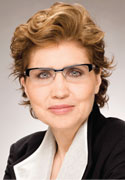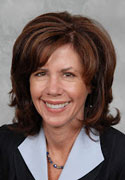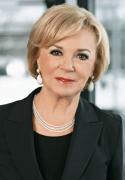Viewpoints: What Can Be Done to Increase the Number of Women on Boards?
Viewpoints: What Can Be Done to Increase the Number of Women on Boards?
With so much focus on women becoming CEOs and joining boards, why isn’t it happening at a faster rate? AS/COA asked six senior-level women to share their perspectives.
While in many countries women now study and work at rates on par with men, real growth in the number of women in leadership positions remains an elusive goal. As far as board representation goes, women hold roughly 16 percent of board positions in the United States and just 7.2 percent in emerging markets. In Latin America, the statistics are stark: In the region’s 100 largest companies, women account for just 5.6 percent of board positions.
With so much focus on women becoming CEOs and joining boards, why isn’t it happening at a faster rate? We asked six senior-level women to answer that question and share their perspectives on what must be done to pave the way for increased equality in the boardroom.
View expert contributions:
- Rossana Fuentes Berain, Editorial Vice President, Grupo Editorial Expansión
- Adele Gulfo, Pfizer, Regional President, Latin America
- Ilene H. Lang, President and Chief Executive Officer, Catalyst
- Grace Lieblein, Vice President, Global Purchasing and Supply Chain, General Motors
- Liz Mohn, Vice-Chairwoman, Bertelsmann Foundation
- Susan Segal, President and CEO, Americas Society and Council of the Americas
This special edition of Viewpoints is published in conjunction with the AS/COA Women's Hemispheric Network, which promotes the economic empowerment of women in business and other professions.
Learn more at: www.as-coa.org/women
Share your viewpoint. Email women@as-coa.org
Rossana Fuentes Berain, Editorial Vice President, Grupo Editorial Expansión
“A major initiative is needed to bridge the gender gap and use it as one of the variables to measure a country’s competitiveness.”
 The various lists published by notable magazines on leading global companies yield convincing proof of the absence of women in the business world. In a recent ranking of the top 100 CEOs, the Harvard Business Review includes just two women. Every year, in our own ranking of "The 500 largest companies in Mexico," the number of women directors never reaches ten. This reality in the twenty-first century is shameful and needs to be reversed, because it is not in proportion with the number of consumers among those same companies.
The various lists published by notable magazines on leading global companies yield convincing proof of the absence of women in the business world. In a recent ranking of the top 100 CEOs, the Harvard Business Review includes just two women. Every year, in our own ranking of "The 500 largest companies in Mexico," the number of women directors never reaches ten. This reality in the twenty-first century is shameful and needs to be reversed, because it is not in proportion with the number of consumers among those same companies.
A major initiative is needed to bridge the gender gap and use it as one of the variables to measure a country’s competitiveness. Through a project of the World Economic Forum in Davos, Mexico, Japan, and Turkey have been challenged to reduce that gap and show better indicators by 2017. What is the path for achieving it? Education, mentoring, and support in the careers of women must be a priority to improve conditions for diversity in the business world, and make way for a generation that has been prepared and is ready. There are no excuses.
Rosanna Fuentes is the editorial vice president of Grupo Editorial Expansión and professor of international studies at the Autonomous Technological Institute of Mexico. She is founder and chair of the advisory committee of Foreign Affairs en Español.
Adele Gulfo, Pfizer, Regional President, Latin America
“Start by encouraging women to find ‘sponsors,’ not ‘mentors.’”
 The evidence is in. Diversity is about enhancing the bottom line, not about fairness or meeting quotas. Companies with diverse boards have superior performance, and women are a vital part of the mix. They not only help bring a diverse perspective to the table, they also influence over 80 percent of consumer purchases so they bring an essential viewpoint.
The evidence is in. Diversity is about enhancing the bottom line, not about fairness or meeting quotas. Companies with diverse boards have superior performance, and women are a vital part of the mix. They not only help bring a diverse perspective to the table, they also influence over 80 percent of consumer purchases so they bring an essential viewpoint.
But, before we see a trend-break in the percentage of women in the boardroom, we need to solve the "leaky pipeline" that diminishes the potential talent pool. You see, in the United States, women enter the workforce at similar rates as men, but the percentage advancing to management drops drastically, especially business/operational (P&L management) roles—a critical qualification for a director in providing relevant experience in running a business or operation.
Landing P&L management roles is not easy. And, as a recent study showed, women get fewer of the "hot jobs" needed to advance when compared to men.
What do we do?
Start by encouraging women to find "sponsors," not "mentors." You may ask, "What is the difference?" and my answer is: "A lot." Simply put, mentors help you personally, acting as a coach and helping with decisions or challenges. But sponsors have significant influence inside an organization and advocate on your behalf, especially when high profile assignments are being discussed and names considered.
Getting more women on boards begins with getting more women in mission-critical P&L roles. And sponsorship is critical to opening doors to these "hot jobs."
Adele Gulfo is the regional president of Latin America in Pfizer’s Emerging Markets Business Unit.
Ilene H. Lang, President and Chief Executive Officer, Catalyst
“Progress is closer than we think.”
 There is a global conversation taking place about gender representation in the boardroom, but the talk hasn’t led to action in the United States. For the seventh year in a row, Catalyst prepared the same headline for the release of our annual Catalyst Census: Fortune 500 Women Board Directors: Women’s representation on Fortune 500 (F500) boards is stalled, with women representing 16.6 percent of all directors.
There is a global conversation taking place about gender representation in the boardroom, but the talk hasn’t led to action in the United States. For the seventh year in a row, Catalyst prepared the same headline for the release of our annual Catalyst Census: Fortune 500 Women Board Directors: Women’s representation on Fortune 500 (F500) boards is stalled, with women representing 16.6 percent of all directors.
Let’s talk about what’s not holding women back. It’s not lack of CEO experience. Almost half of F500 board seats in 2011 are occupied by directors without CEO experience. And it’s not a supply problem with respect to board-ready women. If you look at only one potential source of directors—current Executive Officers of F500 companies—you will find over 700 women, enough to fill every board seat that comes available in the next year (with women to spare). When you consider that boards often seek directors with international expertise, and you add women in top leadership positions at companies in just four countries (Australia, Canada, Great Britain, and Israel), your pool expands to over 2,000 women.
So why the lack of progress? Men join boards every year at a higher rate than women. When Catalyst analyzed new appointments to F500 board seats from 2009 to 2011, we found that men filled 81 percent of the new seats! Thus, women’s appointments to boards have only been sufficient to maintain the status quo, rather than move the needle.
With these factors in mind, we just announced the Catalyst Corporate Board Resource, which connects CEO-endorsed women to board opportunities. CEOs of Catalyst member companies sponsor women executives who are ready for board service by adding them to a directory maintained by Catalyst, and that directory is available to the boards of Catalyst member companies who are seeking women directors. Catalyst research finds that this type of sponsorship opens doors for qualified women who would otherwise be overlooked.
Progress is closer than we think. The leading companies of the United States—the Fortune 100—could jump to 25 percent representation in one year by adding just one woman to their boards. We are optimistic that this year the talk will lead to action.
Ilene H. Lang is the president and chief executive officer of Catalyst, an organization working to change workplaces and improve lives through advancing women into business leadership. She blogs for Catalyzing and The Huffington Post.
Grace Lieblein, Vice President, Global Purchasing and Supply Chain, General Motors
“We are locked in a kind of vicious circle.”
 I believe we need to look into the issue with two different but related views regarding boards versus CEOs.
I believe we need to look into the issue with two different but related views regarding boards versus CEOs.
When you focus on the movements to CEO positions, we need to understand that there aren't enough women in key strategic positions in many industries and companies that would lead them into career paths of CEOs. GM should be pointed as an exception, considering that we do have many women in key operation and strategic roles. Among others, I could mention Mary Barra (GM Senior VP Global Program Management), Susan Docherty (President and Managing Director Chevrolet and Cadillac Europe), Isela Costantini (President GM Argentina, Paraguay, and Uruguay), and myself.
If you look on boards, one of the primary reasons we are not seeing more women joining them is that typically they are looking for candidates who either have board experience or are leading large operations. We are locked in a kind of vicious circle: Because there aren't many women on boards today and also not enough women in CEO or in key positions, they aren't seen as natural candidates for joining boards. (Again, GM can be highlighted as an exception, with three women on its board). In my case, I was recently asked to serve on Honeywell's board because they were willing to have a candidate without previous board experience, but leading a large operation, as GM do Brasil President.
Grace Lieblein is the vice president of global purchasing and supply chain at General Motors. She formly served as president and managing director of GM Brazil. She also serves on the Honeywell Board of Directors.
Liz Mohn, Vice-Chairwoman, Bertelsmann Foundation
“The concept of ‘opting out’ must go.”
 The trend is irreversible: Women and their skills greatly enrich global society and business. Their social graces, creativity, and communication and organizational abilities are indispensable. Successful and self-confident women are omnipresent in academia and the corporate sector, often with greater accomplishments than their male colleagues. So what more should be done for women?
The trend is irreversible: Women and their skills greatly enrich global society and business. Their social graces, creativity, and communication and organizational abilities are indispensable. Successful and self-confident women are omnipresent in academia and the corporate sector, often with greater accomplishments than their male colleagues. So what more should be done for women?
The concept of “opting out” must go. Women around the age of 40 often do not wish to sacrifice their families for their careers. Men should ask themselves if they would be willing to make such a sacrifice.
Women also need to maximize their networks. To men, the need to cultivate contacts—professional and social—is obvious. Aren’t women sometimes too reserved about making their expectations clear, demanding their rights, and marketing themselves?
For many women it remains difficult to have it all: career, children, partner, and household. And major decisions on all those issues often come to the fore between the ages of 30 and 40—the “rush hour” of life. For many people, especially mothers, rush hour is all day. A woman’s work is never done, as they say.
It is here that employers must play a role. They must move away from office time towards flexible working hours and focus on results. By doing so, organizations and their leaders can serve to encourage women.
But let’s be realistic: There will never be equality in everything. For that reason, a quota on women in the boardroom needs to be well thought through.
PS: It isn’t easy for men to accept the new roles women have defined for themselves and the resulting self-confidence. Would eliminating their fear of losing status to successful women perhaps help?
Liz Mohn is the vice-chair of the Bertelsmann Stiftung Board and has served as president of the Spain-based Fundación Bertelsmann since October 2005.
Susan Segal, President and CEO, Americas Society and Council of the Americas
“[W]hy has growing educational equality not translated into the executive suite, the board room, and a larger percentage of the highest-paying jobs?”
 The disappointing reality of today is that only 21 of the Fortune 500 companies have women CEOs and, globally, women hold just 10.5 percent of board seats. Even more bewildering is that for all of the recent discussion and emphasis on women assuming board positions, the percentage has shown no growth in the past seven years, according to Catalyst.
The disappointing reality of today is that only 21 of the Fortune 500 companies have women CEOs and, globally, women hold just 10.5 percent of board seats. Even more bewildering is that for all of the recent discussion and emphasis on women assuming board positions, the percentage has shown no growth in the past seven years, according to Catalyst.
Yet women now earn more than 50 percent of all bachelor’s and master’s degrees, and almost 50 percent of all doctorates. Since the 1970s, the number of women in business programs has grown more than fivefold. Additionally, in the last decade women have accounted for over 35 percent of MBA graduates and over 47 percent of all law students. So why has growing educational equality not translated into the executive suite, the board room, and a larger percentage of the highest-paying jobs?
One of the key reasons is an unwillingness to take a risk. Existing CEOs, boards, and headhunters appear unwilling to take the risk to incorporate new people and different perspectives—so the easy path is just more of the same: same pool of candidates, same process, and same ideas.
Women must also take some responsibility for the current dilemma. They must promote themselves better and proactively find mentors willing to fight for them inside and outside of their companies. Women also need to network more effectively and aggressively, while standing up for their goals and ideas. In Latin America, the culture must also change. To accomplish this, we need strong networks and role models willing to share their stories. And, of course, women must not be deterred from the belief that they can do it all if they so wish—be great mothers as well as outstanding, very successful professionals. The next 10 years can bring amazing change and opportunity for women, but only if we help make it so.
Susan Segal is president and CEO of Americas Society and Council of the Americas. She is also a board member of the Tinker Foundation, Scotiabank, Mercado Libre, and the Latin American Venture Capital Association.
Share your viewpoint. Email women@as-coa.org.







